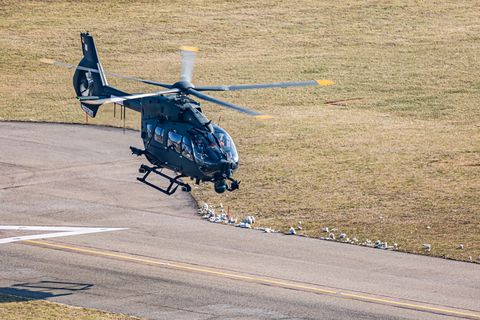Top of the range
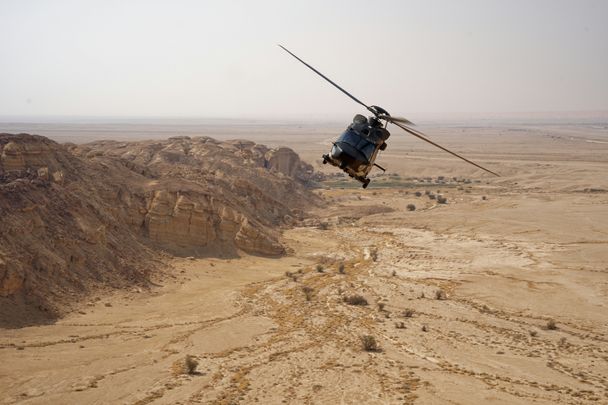
Miles better
According to Alain Fugit, Utility Market Segment Manager at Airbus Helicopters, what makes the H175M so strong, either on paper or in the air, is its exceptional efficiency, giving it an unmatchable range that makes it stand out from the crowd. “If our helicopter weighs 600kg less than its competitors, accommodates the same number of people on board and flies much further... That’s real efficiency. When both are operating on standard tanks the H175M can fly nearly twice as far as its rival, 600 NM.”
Prunel underlines that this superiority was perfectly illustrated in the challenging desert conditions on a flight from Riyadh to Abha, a location at altitude in a mountainous region of the country. Prunel explains: “We flew exactly 486 NM in one go. We left with a full two tonnes of fuel and when we landed we had 470 kg left, which is still plenty. It’s really one of the H175M’s big assets and it’s something its competitors can’t do and the people on board were able to see that for themselves.”
For any helicopter, an ability to fly further is a significant advantage but as Fugit explains, with advancing weapon systems and evolving combat, the ability to fly long distances and spend longer in the air is absolutely critical. “The H175M can travel a long way to get to the battlefront. One of the things we can see in Ukraine is that long‑range firing is becoming more and more precise, and distances are increasing. Today, the zero-to-80-kilometre zone means that if you’re 80 kilometres from enemy artillery, you’re already in danger. Helicopters will have to start from further away. That’s what makes this helicopter, in terms of its range, its autonomy and its technological level, truly exceptional.”
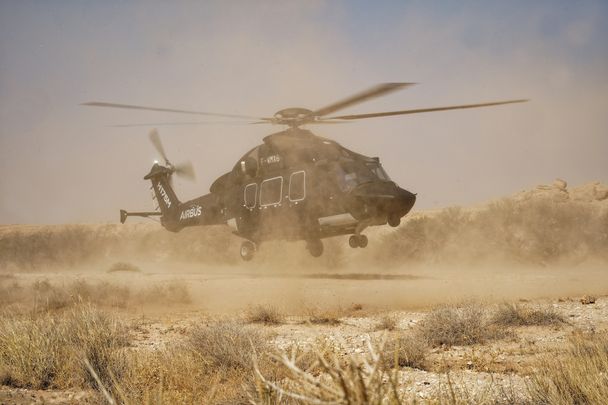
Outstanding performance
Another distinguishing feature that sets the H175M apart is its autopilot which—like everything in Airbus’ range—is designed specifically for helicopters. “A fixed-wing aircraft’s autopilot is based on the speed at which the aircraft is flying,” explains Fugit. “An autopilot designed for helicopters is based on height, so we have an autopilot that is effective at low speeds. The military helicopter pilot often works at low speeds. When they’re shooting, when they’re observing, when they’re on approach to land, many of the critical phases of flight are not transition phases, they’re low-speed phases.”
The ultimate effect of the autopilot’s pilot assistance capabilities is that the pilot is more available to carry out the mission. A pilot at the controls of an old-generation helicopter has to concentrate on holding the hover, while the H175M’s autopilot makes maintaining a hover easier, allowing the pilot to do other things. Customers really wanted to see this for themselves, as Prunel notes: “We were asked to fly from Abha, where you’re already at an altitude of 7,500 feet, to go into some nearby mountains and simulate a Bambi Bucket mission, to put out fires and a winching mission, so we had to be able to hover in the mountains. They asked us to go to the highest peak in Saudi Arabia, called Jabal Sawda, which is at 9,700 feet. That’s a density altitude of around 12,000 feet. We hovered there automatically to perform the winch demonstration. That also impressed them.”
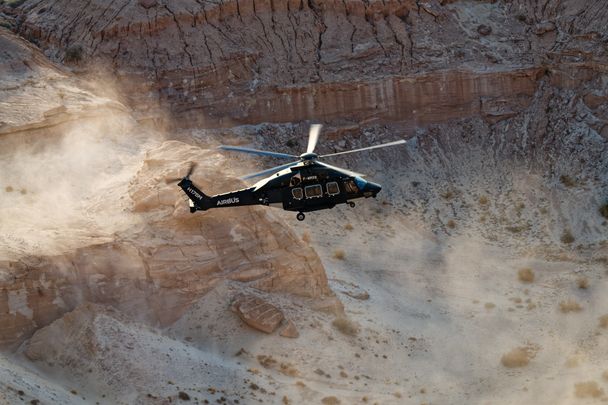
Goodbye to bad vibes
Another area where the H175M offers outstanding performance is in the total absence of vibration in flight and Fugit highlights that this is not the case with every helicopter. “Some competing platforms experience a great deal of vibration at low speeds. In the military market, low-speed vibration is not just about comfort. A military helicopter is an observation platform. If it doesn’t vibrate, you can observe much better. It’s like looking through a pair of binoculars: if you look through your binoculars while moving, it’s a lot harder. What’s more, it’s a shooting platform. At low speed, you’re going to be shooting from the helicopter, so a stable platform is really important.”
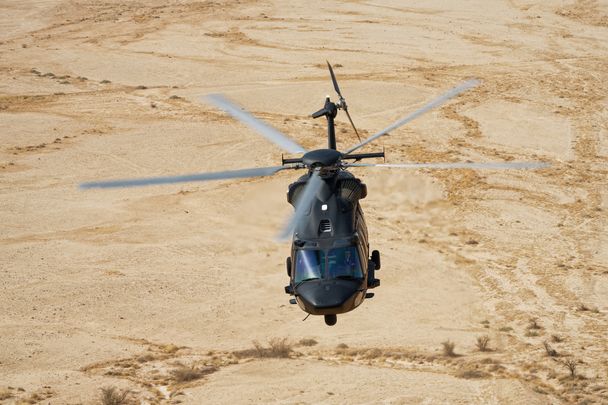
Smooth operations in the desert heat
Flying in Saudi Arabia also demonstrated that the H175M could deal with everything the desert could throw at it. “It’s a hostile environment to fly in,” notes Prunel. “We had a desert survival kit. In the desert you can have sandstorms, we had very strong winds, very heavy turbulence and the helicopter performed well. Sand is an enemy, so the helicopter was equipped with anti-sand filters that served us well on the flights we did, proving that we could land in the dunes and that the filters did their job of protecting the engines.”
Beyond comfortably handling inhospitable conditions the flights also proved that the helicopter could keep its passengers cool and comfortable—something which is absolutely vital for the military personnel it is likely to carry. “This helicopter also has a large cabin and a bigger hold which allows you to take things with you. There’s plenty of room to take stretchers and other kit. In the super‑medium range, you can take 15 soldiers or commandos, so it’s very versatile.”
Crucially the comfort, lack of vibration, reduced noise and high performing air conditioning system means less fatigue for the crew, but according to Prunel, in the military market segment this is even more important for the passengers. “We understand the importance of mistakes that pilots can make when they’re tired. However, this helicopter is not only sold for the pilot, it’s sold for the mission. A military mission could involve flying these commandos for three hours and then landing for their operation. If, after three hours, the soldiers arrive and are uncomfortable, they may not be at their best to do their job on the ground.”
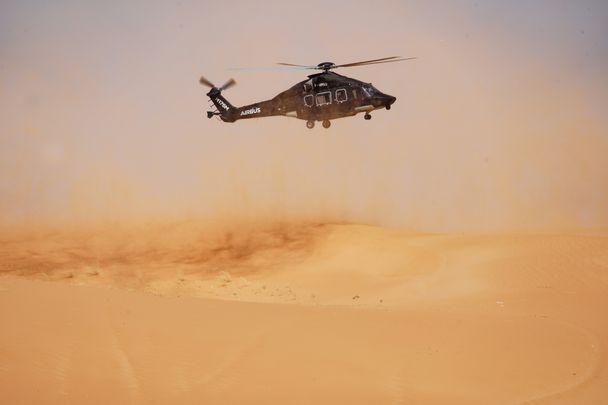
Duality and modularity
A key aspect of Airbus Helicopters strategy is its dual range, which ensures that every advantage available on the civil version will therefore be found on the M variant. The civil version of the H175 has already passed 200,000 flight hours, largely thanks to Energy sector customers—operators who are known to be very demanding, particularly in terms of maintenance. “The duality of the Airbus range means that we have civil helicopters that are tried
and tested. The H175M will therefore benefit from the safety and maintenance standards of the civil market—and avionics which are continuously
upgraded.”
Added to this is Airbus’ extensive experience in the defence sector. “We have a wide range of combat-proven helicopters,” states Fugit. “The Tiger, the NH90, the H145M, H215M and the H225M. All these helicopters are combat-proven.” This helps create an extremely versatile product, as Fugit notes. “Whereas a civil customer will likely buy a helicopter to do a very specific job that has been defined in advance and very often for a specific period, a military customer is buying the capacity to carry out a range of missions that have not yet been identified. These missions will be carried out day and night, in any climate. The customer may not yet even know exactly where they will need this helicopter to fly, so modularity is very important.”
Showing that the helicopter delivers what it says it will is an impressive achievement and this isn’t lost on prospective clients. As Fugit says, “what’s
certain is that everyone who flew on it came away with stars in their eyes. They really did. Everyone was enthusiastic.”

